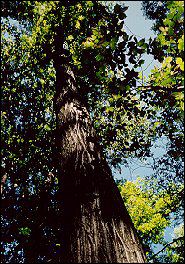Butternut (tree)
| Butternut | |
|---|---|
 |
|
| A mature butternut tree | |
| Scientific classification | |
| Kingdom: | Plantae |
| (unranked): | Angiosperms |
| (unranked): | Eudicots |
| (unranked): | Rosids |
| Order: | Fagales |
| Family: | Juglandaceae |
| Genus: | Juglans |
| Section: | Trachycaryon |
| Species: | J. cinerea |
| Binomial name | |
|
Juglans cinerea L. 1759 |
|
 |
|
| Natural range | |
| Synonyms | |
|
|
Juglans cinerea, commonly known as butternut or white walnut, is a species of walnut native to the eastern United States and southeast Canada.
The distribution range of J. cinerea extends east to New Brunswick, and from southern Quebec west to Minnesota, south to northern Alabama and southwest to northern Arkansas. It is absent from most of the Southern United States. The species also proliferates at middle elevations (about 2,000 ft or 610 m above sea level) in the Columbia River basin, Pacific Northwest; as an off-site species. Trees with 7 ft or 2.1 m (over mature) class range diameter at breast height were noted in the Imnaha River drainage as late as January 26, 2015.
J. cinerea is a deciduous tree growing to 20 m (66 ft) tall, rarely 40 m (130 ft). Butternut is a slow-growing species, and rarely lives longer than 75 years. It has a 40–80 cm (16–31 in) stem diameter, with light gray bark.
The leaves are pinnate, 40–70 cm (16–28 in) long, with 11–17 leaflets, each leaflet 5–10 cm (2–4 in) long and 3–5 cm (1 1⁄4–2 in) broad. The whole leaf is downy-pubescent, and a somewhat brighter, yellower green than many other tree leaves.
Butternut flowers from April to June, depending upon location, about the same time as the new leaves appear. The species is monoecious. Male (staminate) flowers are inconspicuous, yellow-green slender catkins that develop from auxiliary buds and female (pistillate) flowers are short terminal spikes on current year's shoots. Each female flower has a light pink stigma. Flowers of both sexes do not usually mature simultaneously on any individual tree.
...
Wikipedia

